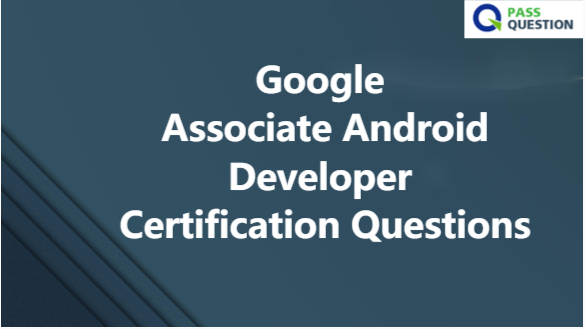Google Associate Android Developer Certification Questions
Do you want to be a Google Associate Android Developer? PassQuestion provides you with the latest Google Associate Android Developer Certification Questions as these products are built by IT examiners so you experience the real exam features in our products. PassQuestion Associate Android Developer exam coverage and accuracy are both excellent. We guarantee that using our latest Google Associate Android Developer Certification Questions will adequately prepare you for your Associate Android Developer exam. With the help of PassQuestion, you can boost your expertise and also can become a Associate Android Developer.

Associate Android Developer Exam Overview
The Associate Android Developer Exam demonstrates the type of skill that an entry-level Android Developer should have as they begin their career. By passing this performance-based exam and earning the Associate Android Developer Certification, you prove that you're competent and skilled in tasks that a developer typically performs. The exam is now also offered to be taken in Kotlin, as well as Java!
How to become an Associate Android Developer
To become an Associate Android Developer, you will need to take an exam on Android Studio, the Android SDK, and either Java or Kotlin (you can choose which language you want to use). After paying and proving your identity, you will be able to complete the exam and must submit within 8 hours.
If your submission is successful, you will then be asked to complete an exit interview, which involves recording spoken answers. If you are successful in this portion, you will be awarded your certificate. Marking can take up to 45 days. Unlike Unity Certification, Associate Android Developer Certification is relatively inexpensive costing just $149 (prices may vary slightly depending on your location). However, you will need to pay again if you don't pass the exam.
Associate Android Developer Exam Content
App functionality
Construct apps that use Android’s messaging, multitasking, connectivity and media services to design full-featured apps primarily for mobile devices.
User interface
Quickly create apps with clean, effective user interfaces that take advantage of Android’s rich UI frameworks.
Data management
Leverage Android’s effective frameworks and techniques to perform or schedule data retrieval/storage efficiently in a mobile environment.
Debugging
Understand the debugging tools in Android Studio and create more reliable and robust apps.
Testing
Be able to test the execution of a running program with the intent of finding errors and abnormal or unexpected behavior.
View Online Associate Android Developer Certification Free Questions
1. "Set the activity content to an explicit view. This view is placed directly into the activity's view hierarchy. It can itself be a complex view hierarchy." This can be done by calling method:
A. setTheme
B. setActionBar
C. setContentTransitionManager
D. findViewById
E. setContentView
Answer: E
2. In a class PreferenceFragmentCompat. As a convenience, this fragment implements a click listener for any preference in the current hierarchy. So, in what overridden method we can handle that a preference in the tree rooted at this PreferenceScreen has been clicked?
A. onCreateRecyclerView
B. onCreateLayoutManager
C. onPreferenceTreeClick
D. onCreatePreferences
Answer: C
3. In Android 8.0, API level 26, some APIs regarding notification behaviors were moved from Notification to NotificationChannel. For example, what should we use instead of NotificationCompat.Builder.setPriority() for Android 8.0 and higher?
A. NotificationCompat.Builder.setImportance()
B. NotificationChannel.setPriority()
C. NotificationChannel.setImportance()
Answer: C
4. A content label sometimes depends on information only available at runtime, or the meaning of a View might change over time. For example, a Play button might change to a Pause button during music playback. In these cases, to update the content label at the appropriate time, we can use:
A. View#setContentDescription(int contentDescriptionResId)
B. View#setContentDescription(CharSequence contentDescription)
C. View#setContentLabel(int contentDescriptionResId)
D. View#setContentLabel(CharSequence contentDescription)
Answer: B
5. SharedPreferences.Editor is an interface used for modifying values in a SharedPreferences object. To mark in the editor that a preference value should be removed, which will be done in the actual preferences once commit() or apply() is called, what method in SharedPreferences.Editor should we use?
A. removeAll()
B. delete(String key)
C. remove(String key)
D. clear()
Answer: D
- TOP 50 Exam Questions
-
Exam
All copyrights reserved 2025 PassQuestion NETWORK CO.,LIMITED. All Rights Reserved.

